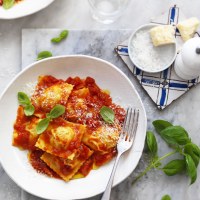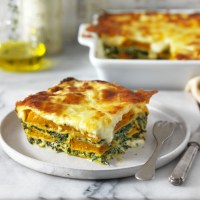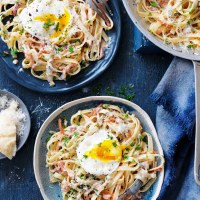How to make pasta from scratch without a machine
Learn everything you need to know about making pasta from scratch by hand. This beginner’s guide to homemade pasta answers all your questions about making, rolling and cooking fresh pasta.
Eating fresh homemade egg pasta is a totally different experience to the usual store-bought pasta, and it’s definitely worth the time and effort. It has an amazingly silky and tender texture with a bit of bite, and the best thing is that you can create beautiful dishes with customised flavours and fillings. Get all the tips and watch how to make pasta below!
Basic pasta dough recipe
Ingredients
- 3 cups (450g) ‘00’ flour, plus extra for dusting
- 1 tsp salt
- 4 eggs (60g each)
- 1 egg yolk
- 2 tsp olive oil
Method
- Spoon flour and salt onto a clean work surface in a circular mound. Create a deep well in the centre, making sure the sides of the mound are high and thick to help retain all the egg mixture inside the flour.
- Crack eggs, egg yolk into the well and drizzle in oil. With a fork, whisk eggs dragging the flour from the sides. Continue until all the flour has been incorporated and dough forms a sticky shaggy dough.
- Using floured hands, knead the dough together, bringing any flour from the bench to form a firm but sticky dough.
- Sprinkle a little more flour on the bench and knead the pasta by pushing down and forward, rotating the dough 45 degrees each time. Continue for 5-10 minutes or until the dough is silky smooth, elastic and springs back when pressed with a finger. If your dough feels wet and tacky, add more flour until it’s smooth.
- Flatten the dough into a disk and wrap with plastic wrap. Rest for 30-60 minutes at room temperature before rolling out.
Watch the process below, and get the full recipes for fettuccine, lasagne or ravioli using your fresh pasta dough.
GET THE RECIPE: Basic Pasta Dough without a pasta machine by Australian Eggs
Pasta dough making tips
Do you need a pasta machine to make pasta?
No, a solid bench and a proper sized rolling pin are all you need to make pasta! A pasta machine can make the process faster and easier, but it’s not necessary.
What is the best flour to use for pasta?
The best flour for pasta dough is 00 flour. It’s traditionally used for pasta because it’s finely milled and has a high amount of protein, resulting in a silky texture with good bite.
Can you use regular flour to make pasta?
Yes, you can replace 00 flour with the same quantity of unbleached plain or all-purpose flour. The results will be quite similar.
Can I use different sized eggs to make this recipe?
This recipe is best made with 60 gram eggs for the right ratio of moisture, fat and flour. However, you can use different sized eggs and add flour or water as required to make the dough drier or wetter.
Do you put salt in pasta dough?
Yes, adding salt to pasta not only seasons it, but it also helps to strengthen the gluten strands in the flour to give the right texture.
How long do you need to rest pasta dough?
Rest pasta dough anywhere between 30 minutes to 2 hours. Rest at room temperature for up to 1 hour, otherwise place in the refrigerator.
How to roll out fresh pasta dough
- Divide dough into four pieces, set one aside, and cover the rest in cling wrap or a clean tea towel. Have extra flour on hand for dusting, and prepare a tray dusted with extra flour for your finished pasta.
- Dust work surface and rolling pin with a little flour and start rolling. After every roll, make a quarter turn and repeat the same movement until dough is at least 1mm thick. To make rolling out easier, try to keep the shape and size fairly even from end to end.
- If the sheet of dough becomes too long, simply cut it in half on a cutting board. Dust one half with flour and cover it with a tea towel, then continue rolling the other.
- Once you've rolled out the dough, cover it as you finish rolling the rest, or cut and form your pasta shapes and place onto trays dusted with extra flour. Sprinkle extra flour over the top and keep it covered as you continue to prepare remaining pasta.
Why is my pasta dough so hard to roll out?
If your pasta dough is difficult to roll out and keeps springing back into place, cover and let it rest for another 15 minutes. Resting the dough allows the flour to hydrate and the gluten network to relax. If it hasn’t rested long enough, the dough will be too dry and elastic to roll out.
If your pasta dough has rested but looks rough and tears instead of rolling out smoothly, it may not be hydrated enough. Knead more water into it a teaspoon at a time until it becomes smooth and elastic. Let rest again before rolling out.
If your dough is too sticky, make sure to sprinkle flour over your working surface. If it is still too sticky, it may be overly hydrated. Sprinkle flour over your surface and knead into the dough until it is pliable and smooth.
Why is my homemade pasta chewy?
If your pasta is chewy once cooked, it may be too thick. Take your time and roll the dough out very thinly, to about 1mm thick. You should be able to see the outline of your hand through the dough.
How to cook fresh pasta
- To cook fresh pasta, bring a large pot of salted water to the boil. A good rule of thumb is to add 1 tablespoon of salt to every 4 litres of water. This amount of water will cook 500 grams of pasta at a time.
- Once water is boiling, add fresh pasta in small batches. Stir immediately to separate strands and prevent pasta from sticking to the bottom of the pan.
- Cook each batch for about one and a half minutes. Watch for changes in colour and texture. Cooked pasta will be tender and still have a bite in the centre. Undercooked fresh pasta will have a pasty texture from undercooked egg and flour.
- Drain immediately and add to sauce or toss sauce through immediately.
How to store pasta dough
You can store pasta dough either rolled or unrolled.
- How to store a ball of pasta dough in the fridge
Wrap the dough tightly in cling wrap, refrigerate and use within 2 days. Note that the dough will acquire a greyish tinge, this may look strange but it won’t affect the flavour or texture. - How to store a ball of pasta dough in the freezer
Wrap the dough tightly in cling wrap and place into a zip-lock bag, removing as much air as possible, and freeze for up to three weeks. Defrost overnight in the refrigerator until it is soft and malleable. - How to store pasta shapes in the fridge
Toss with extra flour, place in a zip-lock bag and use within two days. - How to store pasta shapes in the freezer
First, let the pasta dry on the tray for 15-60 minutes, or until it holds its shape. Then place it in a zip-lock bag, label and freeze for up to 8 months.
What to make with fresh pasta dough
GET THE RECIPE: Creamy Chicken, Mushroom and Chive Fettuccine by Australian Eggs
Fettuccine is one of the simplest shapes for fresh pasta dough. Make a simple chicken and mushroom sauce to enjoy your fresh pasta.
GET THE RECIPE: Roasted Pumpkin and Spinach Lasagne by Australian Eggs
Turn your dough into lasagne sheets. You can make classic lasagne, or try this equally satisfying vegetarian version with sweet roasted pumpkin and spinach.
Go the extra mile by filling your pasta with a tasty filling and making ravioli.
Get more recipes from scratch
Interested in making more things from scratch like focaccia, calzone and pide? Check out the recipes below.




















